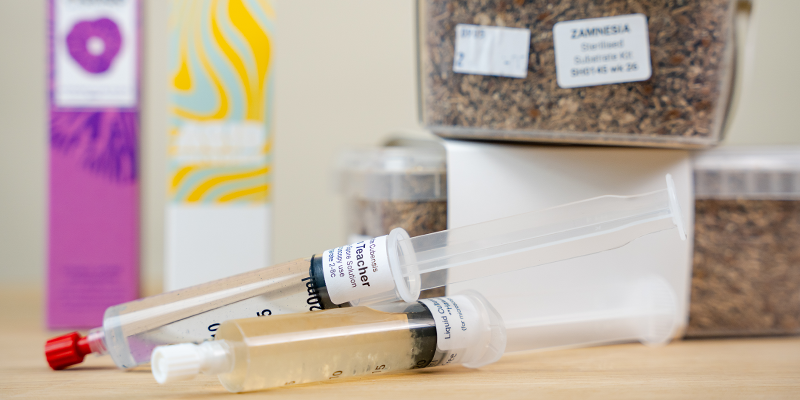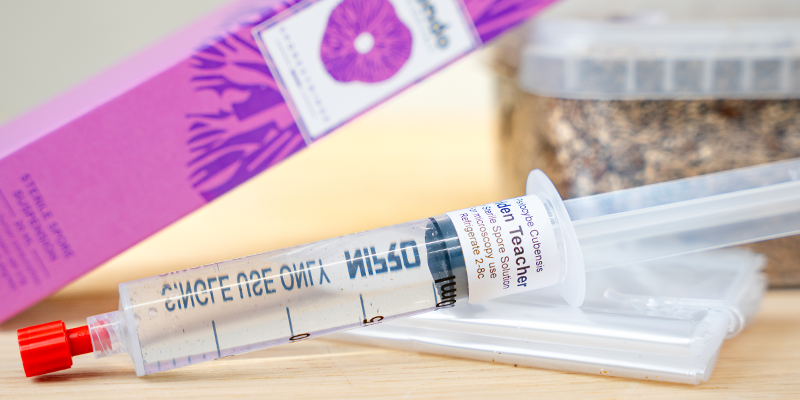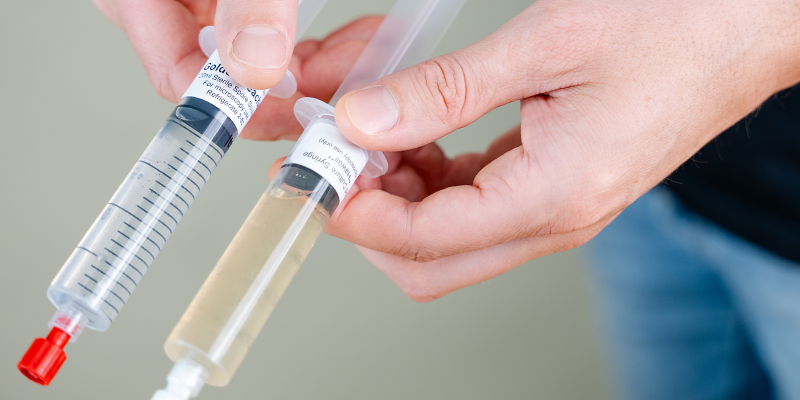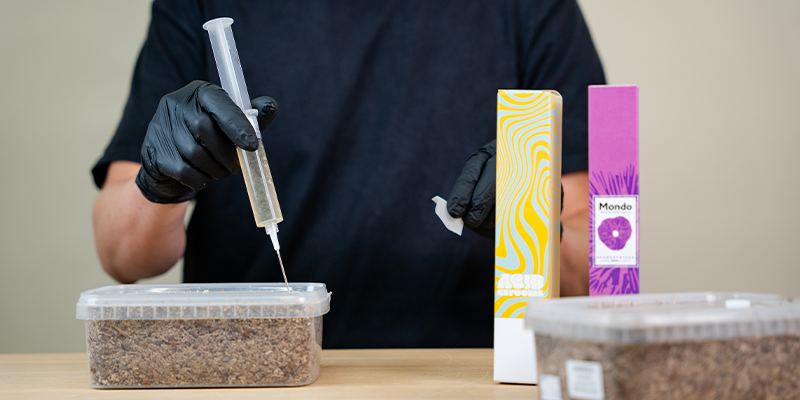
Liquid Culture Syringes Vs Spore Syringes: A Comparison
Fancy yourself a budding mushroom cultivator? If so, you need to know the differences between spore syringes and liquid culture. In this comprehensive guide, we clear up any misinformation surrounding these mushroom cultivation tools, so you can decide which is best for your next mushroom grow project.
The world of mycology and mushroom cultivation is vast, and the terminology can be intimidating and confusing for novices. But we’re here to set the record straight on one often-muddled distinction: the difference between mushroom spore syringes and liquid culture.
Spore syringe and liquid culture: the basics

Both of these tools can effectively be used to grow mushrooms, but their exact contents and application differ. In what follows, we explore all you need to know about spore syringes and liquid culture syringes, so you can decide which one might be best for you.
What s a spore syringe?
A spore syringe is just that: a syringe containing mushroom reproductive material—i.e. spores—in a solution of sterilised water. Spores are comparable to seeds, in that they must germinate first before mushrooms can grow. In order to successfully cultivate mushrooms using spore syringes, growers inject the solution onto a viable substrate, after which mycelium will start to grow and “colonise” the substrate. This process can take several weeks up to a few months to occur. It’s worth noting that the spores in these syringes tend to contain a great degree of genetic variability, so numerous outcomes are possible when inoculating.
Spore syringe: key takeaways
- Contains mushroom spores in sterilised water
- Must be added to substrate in order to germinate and create mycelium
- The colonisation process can take weeks or months
- Spore syringes tend to display low contamination rates
- High degree of genetic variability
- Easy to access
- Long shelf-life (ideal storage location is in the fridge)
What is liquid culture?
Whereas spore syringes contain spore solution, liquid culture contains living mycelium in a sugar/honey solution. In essence, liquid culture is the next step beyond spore syringes, as the germination and isolation process is already complete. This means that once liquid culture is added to the substrate, colonisation occurs quickly, speeding up the entire mushroom cultivation process. Liquid culture also displays a low contamination rate, although its shelf-life is a bit shorter. Importantly, most high-quality liquid culture syringes are monocultures, meaning they contain just one genetic lineage.
Liquid culture: key takeaways
- Contains mycelium in a substrate (e.g. sugar/honey solution)
- Allows for fast colonisation (1–3 weeks)
- Generally contains just one mushroom variety (with some exceptions)
- Low contamination rates
- May be difficult to access depending on jurisdiction
- Relatively short shelf-life; must be stored in the refrigerator
What are the differences between a spore syringe and liquid culture?

Although some of the main differences between these two mushroom cultivation vessels are likely clear from the information above, let’s get into some more detail to see how each variable influences the entire cultivation process.
Speed
The spores in a syringe have to germinate and create a mycelial network before the substrate can be colonised. This whole process can take months to occur, which some cultivators may not be partial to. On the other hand, as liquid culture contains live mycelium, as soon as it is administered to the substrate, colonisation can occur in as little as 1–3 weeks.
Genetics
Assuming the liquid culture was created with an agar culture, the genetics should be pure and represent just one mushroom variety. Given this, a specific variety can be selected for beneficial traits relating to size, yield, etc. As such, growers using liquid culture should have a better idea of what the final flushes will look like, and can maintain more control over the entire operation. Spore syringes, on the other hand, feature thousands of different varieties to isolate, which makes for competition among the different subspecies and greater variability in the flushes.
Note that some lower-quality liquid culture products may contain more than one mushroom variety, so keep an eye out, and only purchase from high-quality sources if you desire a liquid monoculture.
Contamination sensitivity
In general, both spore syringes and liquid culture should display low rates of contamination, if prepared correctly. Although the spores in a solution should be uncontaminated, it’s recommended to first germinate on agar to see what you’re working with. From here, the mycelium can be used to colonise a viable substrate. On the other hand, well-prepared liquid culture should be almost certainly free of contamination, but you should always still operate under sterile conditions!
Legality
There is some distinction in the legality of spore syringes vs liquid culture. Because the spores in syringes have not yet germinated into mycelium, they are considered legal in most jurisdictions. On the other hand, the legality of liquid culture containing Psilocybe mycelium is more nebulous, and may vary from place to place. We recommend reviewing the regulations in your region before purchasing live Psilocybe mycelium. Of course, if you're looking to buy liquid culture for culinary mushrooms (e.g. oyster, shiitake, etc.), you should have absolutely no problem with legality.
Shelf-life
Generally, spore syringes last longer than liquid culture, and can even be stored outside of the fridge, in an airtight container, for up to 6 months or so. That said, a fridge is still the ideal location for spore syringes. Liquid culture, on the other hand, must be stored in the fridge, and can quickly spoil if it’s not. When stored correctly, liquid culture should remain viable for up to around 2 months after receiving the product.
Note: spore syringes are not to be confused with spore prints, which last much longer as they are not hydrated.
Can you make liquid culture with a spore syringe?

Absolutely; you can inject spores into the sugar/honey solution used to create liquid culture, but you will not be able to isolate one specific mushroom variety. Moreover, there is some risk of contamination in this process, so again, it’s recommended to first germinate the spores on agar before creating your liquid culture. This way, you can minimise contamination and potentially select for one type of mushroom variety.
Which is better for mushroom cultivation: spore syringes or liquid culture?

Regarding whether you should choose a spore syringe or liquid culture for your fungi cultivation exploits, it’s important to note that one isn’t inherently better than the other. That said, given the increased speed of colonisation, potentially lower risk of contamination, and low genetic variability of liquid culture, many experienced mushroom cultivators tend to prefer this option. However, for hobby cultivators, as well as the more experienced, spore syringes offer welcome benefits including a longer shelf-life and easier accessibility—and can themselves be effectively turned into liquid culture.
-
 3 min
25 April 2022
What Is A Magic Mushroom Spore Vial?
Embarking on the journey of magic mushroom cultivation? One of the first things you need to do is source some spores. But should you choose a vial or a syringe? Here we explain the benefits of...
3 min
25 April 2022
What Is A Magic Mushroom Spore Vial?
Embarking on the journey of magic mushroom cultivation? One of the first things you need to do is source some spores. But should you choose a vial or a syringe? Here we explain the benefits of...
-
 7 min
4 November 2021
What Is Liquid Culture, And How Do You Make It?
Favoured by the casual mushroom connoisseur and those well-versed in mycology, liquid culture is frequently used to produce high-quality mushrooms at home. But what is liquid culture, and how is it...
7 min
4 November 2021
What Is Liquid Culture, And How Do You Make It?
Favoured by the casual mushroom connoisseur and those well-versed in mycology, liquid culture is frequently used to produce high-quality mushrooms at home. But what is liquid culture, and how is it...













 United States
United States










